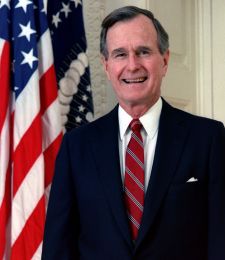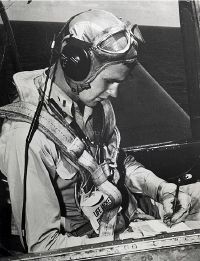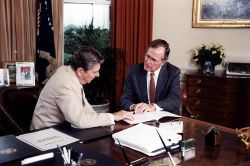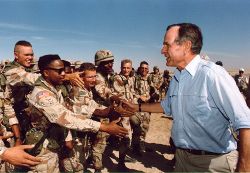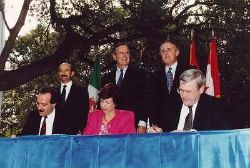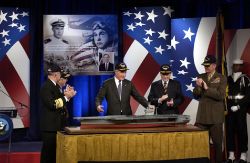George H. W. Bush
| Term of office | January 20, 1989 – January 20, 1993 |
| Preceded by | Ronald Reagan |
| Succeeded by | William Jefferson Clinton |
| Date of birth | June 12, 1924 |
| Place of birth | Milton, Massachusetts |
| Date of death | November 30 2018 (aged 94) |
| Place of death | Houston, Texas, U.S. |
| Spouse | Barbara Pierce |
| Political party | Republican |
George Herbert Walker Bush (June 12, 1924 - November 30, 2018) was the 41st president of the United States of America (1989–1993). Prior to being president, Bush had served as a U.S. congressman from Texas (1967–1971), ambassador to the United Nations (1971–1973), Republican National Committee chairman (1973–1974), chief of the U.S. Liaison Office in Beijing (1974–1976), director of the Central Intelligence Agency (1976–1977), chairman of the First International Bank in Houston (1977–1980), and the 43rd vice president of the United States, under President Ronald Reagan (1981–1989). A decorated naval aviator, Bush is the last World War II veteran to have served as president. Bush was known for his pursuit of moderate policies in both domestic and foreign policy and for his diplomatic savvy.
During the final days of the Cold War, he was responsible for managing U.S. foreign policy during the delicate transition of the Soviet Union and Eastern Europe from being communist states to becoming liberal democracies. He championed the concept of a “New World Order” where international law and global consensus would replace military and strategic confrontation as a means of accomplishing diplomatic objectives. U.S. conduct in the Gulf War exemplified this, when President Bush rallied a global coalition to push back Iraqi forces after their invasion of Kuwait under Saddam Hussein. In December 1989, in contradiction to that policy, President Bush ordered the invasion of Panama to remove General Manuel Noriega from power without an international consensus.
In domestic policy, Bush's most notable initiative was the Omnibus Budget Reconciliation Act of 1990, a controversial compromise with congressional Democrats that traded spending controls for tax increases in order to balance the federal budget. This conciliation incensed Republicans, to whom Bush had promised "No New Taxes" during the 1988 presidential campaign. Bush also introduced funding for faith-based social service organizations provided that the facilities and programs are available to all.
The Bush political "dynasty" has been compared to that of the Adams and the Kennedy families. Bush is the father of the 43rd president, George Walker Bush, and the 43rd governor of Florida (1999-2007), Jeb Bush. George H. W. Bush's father, Prescott Bush, was a United States senator from Connecticut.
Early life
George Herbert Walker Bush was born in Milton, Massachusetts, on June 12, 1924, to Prescott Bush and Dorothy Walker Bush. He was named for his maternal grandfather, George Herbert Walker, Sr. Of his upbringing, Bush has said, "People say I was a man of privilege and by that they mean money, but I was privileged in the question of values—a mother and father who were determined to help their kids be good people."[1]
Bush began his formal education at the Greenwich Country Day School in Greenwich, Connecticut. He attended Phillips Academy in Andover, Massachusetts, from 1936 to 1942, where he captained the baseball and soccer teams and was a member of an exclusive fraternity Auctoritas, Unitas, Veritas—Latin for "Authority, Unity, Truth." While at Phillips Academy, Bush first learned of the surprise Attack on Pearl Harbor on December 7, 1941.
World War II
After graduating from Phillips Academy in June 1942, Bush joined the United States Navy on his eighteenth birthday to become an aviator. After completing the ten-month course, he was commissioned as an ensign in the U.S. Naval Reserve on June 9, 1943, several days before his nineteenth birthday, which made him the youngest naval aviator to that date.
After finishing flight training, he was assigned to Torpedo squadron VT-51 as a photographic officer in September 1943. As part of Air Group 51, his squadron was based on USS San Jacinto in the spring of 1944. San Jacinto was part of Task Force 58 that participated in operations against Marcus Island and Wake Island in May, and then in the Marianas during June. On June 19 the task force triumphed in one of the largest air battles of World War II. On his return from the mission Bush's aircraft made a hard forced-water landing. A submarine rescued the young pilot, although the plane was lost as well as the life of his navigator. On July 25, Bush and another pilot received credit for sinking a small Japanese cargo ship off Palau.
Through 1944, Bush had flown 58 combat missions, for which he received the Distinguished Flying Cross, three Air Medals, and the Presidential Unit Citation awarded while he served aboard the San Jacinto.
To make use of his valuable combat experience, Bush was reassigned to Norfolk Navy Base and put in a training wing for new torpedo pilots. He was later assigned as a naval aviator in a new torpedo squadron, VT-153. After Japan surrendered in August 1945, Bush was honorably discharged from the U.S. Navy.
Postwar
After the war, Bush entered Yale University. There, he joined the Delta Kappa Epsilon fraternity, of which he was elected president. He also captained the Yale baseball team where, as a left-handed first baseman, Bush played in the first College World Series. As a senior he was—like his son George W. Bush (1968) and his father Prescott S. Bush (1917)—inducted into the Skull and Bones secret society, which helped him to build friendships and future political support. The connections that he made from his membership in Skull and Bones later proved vital during his presidential campaign.
In the 1940s, Bush ventured into the highly speculative Texas oil exploration business with considerable success. He secured a position with Dresser Industries, on whose board of directors his father had served 22 years. George Bush and the Liedtke brothers created the Zapata Corporation in 1953 as Zapata Oil. Authors Kevin Phillips, Daniel Yergin, and others suggest that Bush had undercover ties to the Central Intelligence Agency at this time.
Congressman and Failed Senate Campaigns
In 1964 Bush ran for the U.S. Senate. In the Republican primary, Bush ran first with 62,985 votes, but his total was 44.1 percent, which was not the required majority. He was thus forced into a runoff primary with Jack Cox, also of Houston, the 1962 Republican gubernatorial nominee, who had 45,561 votes (31.9 percent) in the primary. A third candidate, Robert Morris of Dallas, polled 28,279 ballots (19.8 percent).
Bush easily prevailed in the GOP runoff, with 49,751 (62.1 percent) to Cox's 30,333 (37.9 percent). As the Republican nominee, Bush then ran a campaign against the incumbent Democratic Senator Ralph Yarborough, making issue of Yarborough's support for the Civil Rights Act of 1964. At the time, many Southern politicians (including the Republican Senator John Tower of Texas) opposed the legislation on constitutional or libertarian grounds. Bush called Yarborough an "extremist" and a "left wing demagogue," while Yarborough countered by calling Bush a "carpetbagger" trying to buy a Senate seat "just as they would buy a seat on the New York Stock Exchange." Bush lost in a Democratic landslide but performed considerably better than did the GOP presidential nominee, Senator Barry M. Goldwater of Arizona.
After his defeat, Bush did not give up on elective politics; he was elected in 1966 and 1968 to the House of Representatives from Texas' 7th Congressional District. During his career in Congress, Bush was very supportive of contraceptives and family planning—so much so that he was known as "Rubbers."[2] He was a supporter of Planned Parenthood, of which his father Prescott had been the financial chairman. He criticized Pope Paul VI for his encyclical Humanae Vitae, which reiterated the Roman Catholic Church's opposition to contraceptives.[2]
In 1970 Bush relinquished his House seat to seek the Republican nomination for the Texas senate seat up for re-election. He easily defeated conservative Robert Morris, a 1964 candidate, by a margin of 87.6 percent to 12.4 percent. Bush expected that he would again face Democratic Senator Yarborough. But former Congressman Lloyd Bentsen, a native of Mission, Texas, defeated Yarborough in the Democratic primary, 816,641 votes (53 percent) to 724,122 (47 percent). Yarborough then endorsed Bentsen.
Because there was no presidential election in 1970, turnout in Texas was unusually low in the general election. Bentsen defeated Bush by a margin similar to that in his primary victory over Yarborough. Bentsen later became the Democratic Party nominee for vice president in the 1988 presidential election and, teamed with Massachusetts governor Michael Dukakis, lost to Bush and running mate Dan Quayle.
1970s Appointive Offices
Following the 1970 election loss, President Richard Nixon appointed Bush to the post of ambassador to the United Nations, a position that he held from 1971 to 1973.
After his re-election in 1972, Nixon asked Bush to become chairman of the Republican National Committee. Bush held this position during the Watergate scandal, when the popularity of both Nixon and the Republican Party plummeted. Bush defended Nixon steadfastly, but later as Nixon's complicity became clear he focused more on defending the Republican Party while still maintaining loyalty to Nixon.
After Nixon's resignation in 1974, Bush was considered for appointment as the replacement vice president, but new President Gerald Ford chose Nelson Rockefeller instead. Ford appointed Bush to be chief of the U.S. Liaison Office in the People's Republic of China (since the United States at the time maintained official relations with the Republic of China on Taiwan and not the People's Republic of China, the liaison office did not have the official status of an embassy and Bush did not formally hold the position of "ambassador" even though he unofficially acted as one).
In 1976 Ford brought Bush back to Washington to become director of the Central Intelligence Agency (CIA). Bush served in this role for 355 days, from January 30, 1976 to January 20, 1977.[3] Prior to Bush's appointment, the CIA had been rocked by a series of scandals, including revelations based on investigations by the Senate's Church Committee, concerning alleged CIA illegal and unauthorized activities, and Bush was credited with helping to restore the agency's morale and public standing.
Bush has since commented that he did not particularly enjoy this string of jobs, saying he never wanted to be a "career bureaucrat." He was, however, able to build his subsequent rise to national prominence in politics in part upon the experience he gained from this succession of appointments after his Senate defeat in 1970.
After Jimmy Carter's Democratic administration came to power in 1977, Bush left public life to become chairman of the First International Bank in Houston. He also became an adjunct professor of administrative science at Rice University in the Jones School of Business in 1978, the year it opened. The course, Organization Theory, involved lectures from Bush regarding the organizations he headed—the Central Intelligence Agency, the National Republican Party, a U.S. congressional office, the United States Mission to China, and an oil exploration company. During this time, he also became a board member of the Committee on the Present Danger.
1980 Presidential Campaign
Bush decided to run for president in 1980, citing his wide range of government experience. Despite Bush's backing of the GOP establishment, Ronald Reagan, former governor of California, gained front-runner status.
In the contest for the nomination, Bush represented the traditional, East Coast liberal-moderate wing of the Republican Party, whereas Reagan represented the party's conservative, Western libertarian faction. Bush attacked Reagan as being “too conservative,” deriding the latter's supply-side influenced plans for massive tax cuts as "voodoo economics."
Bush started strongly, winning the Iowa caucus that starts the primary season. He then told the press that he had "Big Mo" (or momentum). Reagan came back to decisively win the first primary in New Hampshire, however, and Bush's "mo" evaporated.[4] With a growing popularity among the Republican voting base, Reagan won most of the remaining primaries and the nomination.
After some preliminary discussion of choosing former president Gerald Ford, Reagan selected Bush as his running mate. Interestingly, Bush had declared during the campaign for the nomination that he would never be Reagan's vice president.
The two candidates were in stark contrast to one another, as Bush was many things Reagan had not been—a life-long Republican, a combat veteran, an internationalist with United Nations, Central Intelligence Agency, and had experience with China. Bush was also more moderate in both his economic positions and political philosophy than was Reagan, which he altered after accepting the nomination. Before Reagan chose him, for example, Bush had supported legalized abortion, but he later compromised and changed his position so that it was more in line with Reagan's.
Vice Presidency
As vice president, Bush was loyal to Reagan and kept any policy differences hidden. Bush did not wield strong power within the Reagan administration, but he did have some influence on Reagan's staffing and was given some line responsibilities. Reagan kept Bush busy on overseas diplomatic trips.
The Reagan/Bush ticket won again by a huge landslide in 1984 against the Democrats' Walter Mondale/Geraldine Ferraro ticket, winning all but one state (Mondale’s home state of Minnesota).
During his second term as vice president, Bush became the first vice president to become acting president when, on July 13, 1985, President Reagan underwent surgery to remove polyps from his colon. Bush served as acting president for approximately eight hours.
When the Iran-Contra Affair broke in 1986, Bush claimed that he had been "out of the loop" and unaware of the Iran initiatives related to arms trading.[5] Some were skeptical of this claim, but Bush was never charged with any wrongdoing.
1988 presidential campaign
In 1988, after nearly eight years as vice president, Bush again ran for president, this time with Reagan's backing. Though considered the early front runner for the Republican nomination, Bush came in third in the Iowa caucus, beaten by winner U.S. Senator Bob Dole and runner-up televangelist Pat Robertson. Bush rebounded to win the New Hampshire primary, however, partly because of negative television commercials aimed at Dole. Once the multiple-state primaries began, Bush's organizational strength and fundraising lead proved to be too much for Dole and Robertson to handle, securing for him a majority of convention delegates.
Leading up to the 1988 Republican National Convention, there was much speculation as to Bush's choice of running mate. In a move anticipated by few and later criticized by many, Bush chose little-known U.S. Senator Dan Quayle of Indiana. On the eve of the Republican Convention, Bush looked to be in trouble: in most polls, he trailed Democratic nominee Michael Dukakis, then Massachusetts governor, by double digits.
At the convention, Bush answered critics of his speaking ability by giving perhaps the best speech of his public career, widely known as the "Thousand points of light" speech[6] for his use of that phrase to describe his vision of American community. Bush's acceptance speech and a generally well-managed convention catapulted him ahead of Dukakis in the polls, and he held the lead for the rest of the race. Bush's acceptance speech at the convention included the famous pledge, “Read my lips: no new taxes.”
The campaign was noteworthy for its highly negative television advertisements, especially by the Bush campaign.[7] Dukakis' unconditional opposition to capital punishment got him into trouble during the U.S. presidential debates. Moderator Bernard Shaw asked Dukakis hypothetically if Dukakis would support the death penalty if his wife were raped and murdered. Dukakis' subsequent response appeared oddly wooden and technical, and helped to reinforce his image as "soft on crime." These gaffes helped to enhance Bush's stature as a possible commander-in-chief in comparison to the Massachusetts governor. Shortly after the election, Kitty Dukakis, the candidate's wife, checked into the Betty Ford Center for recovery from alcoholism. She reportedly had a longtime problem with alcohol and had resorted to drinking mouthwash. Although staffers had effectively hidden this from the media reporters, Mrs. Dukakis' addiction had strained the relationship.
On election night, the George Bush/Dan Quayle ticket beat the Michael Dukakis/Lloyd Bentsen ticket soundly in the Electoral College by 426 to 111 (Bentsen received one vote). In the nationwide popular vote, Bush took 53.4 percent of the ballots cast while Dukakis gained 45.6 percent. Bush was the first serving vice president to be elected president since 1836.
Presidency 1989-1993
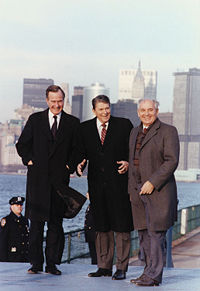
After the extremely negative 1988 presidential campaign, Bush tried to begin his administration on a positive note. In his inaugural address, Bush alluded to the fact that the Soviet Union and its client states were crumbling and that a new era had dawned:
I come before you and assume the Presidency at a moment rich with promise. We live in a peaceful, prosperous time, but we can make it better. For a new breeze is blowing, and a world refreshed by freedom seems reborn; for in man's heart, if not in fact, the day of the dictator is over. The totalitarian era is passing, its old ideas blown away like leaves from an ancient, lifeless tree. A new breeze is blowing, and a nation refreshed by freedom stands ready to push on. There is new ground to be broken, and new action to be taken.[8]
Policies
Cold War
Foreign policy, especially in relation to the Soviet Union and its former client states, was the center of the Bush presidency from its first days.
President Bush and Soviet premier Mikhail Gorbachev declared a U.S.-Soviet strategic partnership at a summit in July 1991, decisively marking the end of the Cold War. President Bush declared that U.S.-Soviet cooperation during the Persian Gulf War in 1990–1991 had laid the groundwork for a partnership in resolving bilateral and world problems.
With the Cold War at its end, George Bush saw his position as vital in the transition to the "new world order." He said: "I hoped it would end but I wasn't sure that it would end that fast. I wasn't sure the wall would come down. I wasn't sure that Germany would be unified. I wasn't sure that the Soviet Union would have dramatically imploded as it did."[9] Bush tried to manage these events through a personal relationship with Soviet premier Mikhail Gorbachev, mostly with great success.
Manuel Noriega
In December 1989, Bush ordered an invasion of Panama, called Operation Just Cause, in response to the death of an American soldier and to Panamanian dictator Manuel Noriega's various transgressions, including drug trafficking and democratic suppression. The invasion made use of an expeditionary force of 25,000 troops and state-of-the-art military equipment, making it the largest American military operation since the Vietnam War.
Noriega had at one time been a U.S. ally, but he was increasingly using Panama to funnel drugs, especially cocaine, from South America to the United States. The deteriorating situation in Panama, in what was supposedly an American protectorate, had been a growing embarrassment for the Reagan Administration and it was a problem that President Bush inherited.
The military operation took place under supervision of the chairman of the joint chiefs of staff, General Colin Powell, who as National Security Advisor for President Reagan knew the Panama situation and dictator Noriega well. The invasion was preceded by massive protests in Panama against Noriega. Bush's secretary of defense, Dick Cheney, visited American troops in Panama right after the invasion, and President Bush visited Panama with his wife in June 1992, to give support to the first post-invasion Panamanian government.
Gulf War
As president, Bush is perhaps best known internationally for leading the United Nations coalition in the 1990–1991 Gulf War. In 1990, Iraq, led by Saddam Hussein, invaded its oil-rich neighbor to the south, Kuwait, claiming that its territory rightfully belonged to Iraq. The broad coalition that emerged in response to the invasion sought to remove Iraqi forces from Kuwait and ensure that Iraq did not invade Saudi Arabia. The operation was called Desert Shield.
On November 29, the UN passed a resolution establishing a deadline that authorized the nations allied with Kuwait “to use all necessary means” if Iraq did not withdraw from Kuwait by January 15, 1991. Iraq refused to comply, and fighting began on January 17, 1991, when U.S.-led air units launched a devastating series of air attacks against Iraq, in an operation referred to as Desert Storm.[10]
In a military decision that would later be questioned, President Bush ordered a cessation of combat operations after achieving his stated objectives of liberating Kuwait and forcing Iraqi withdrawal, thereby allowing Saddam Hussein to stay in power. Secretary of Defense Dick Cheney noted that invading the country would get the United States "bogged down in the quagmire inside Iraq." Bush later explained that he did not give the order to overthrow the Iraqi government because it would have "incurred incalculable human and political costs... We would have been forced to occupy Baghdad and, in effect, rule Iraq."[11]
In explaining to Gulf War veterans why he chose not to pursue the war further, President Bush said, "Whose life would be on my hands as the commander-in-chief because I, unilaterally, went beyond the international law, went beyond the stated mission, and said we're going to show our macho? We're going into Baghdad. We're going to be an occupying power—America in an Arab land—with no allies at our side. It would have been disastrous."[12]
President Bush's popularity rating in America soared to a term-high during and immediately after the success of the military operations.
NAFTA
Bush's government, along with the progressive conservative Canadian prime minister, Brian Mulroney, spearheaded the negotiations of the North American Free Trade Agreement (NAFTA), which President William Jefferson Clinton signed in 1993.
The agreement, which was highly controversial, was designed to remove barriers to trade among the North American countries of Canada, the United States, and Mexico. Proponents said that the agreement would enhance economic growth throughout the newly created trade zone, while critics claimed that jobs would be outsourced from the United States to Mexico.
Domestic initiatives
Points of Light
President Bush devoted attention to voluntary service as a means of solving some of America's most serious social problems. He often used the "thousand points of light" theme to describe the power of citizens to solve community problems. In his 1989 inaugural address, he said, "I have spoken of a thousand points of light, of all the community organizations that are spread like stars throughout the Nation, doing good."[13]
Four years later, in his report to the nation on The Points of Light Movement, President Bush said:
Points of Light are the soul of America. They are ordinary people who reach beyond themselves to touch the lives of those in need, bringing hope and opportunity, care and friendship. By giving so generously of themselves, these remarkable individuals show us not only what is best in our heritage but what all of us are called to become.[14]
In 1990, the Points of Light Foundation was created as a nonprofit organization in Washington to promote this spirit of volunteerism. In 2007, the Points of Light Foundation merged with the Hands On Network with the goal of strengthening volunteerism, streamlining costs and services and deepening impact.[15] Points of Light, the organization created through this merger, and its network of innovative volunteer-mobilizing organizations serves more than 250 cities across 37 countries around the world. In 2015, Points of Light celebrated 25 years with a Conference on Volunteering and Service, and in 2017 in an historic moment that included all five former U.S. presidents, Barack Obama, George W. Bush, Bill Clinton, George H.W. Bush, and Jimmy Carter, Points of Light recognized five individuals for their volunteer efforts during a series of hurricanes along the Gulf Coast.[15]
Taxes
Throughout his political career, George Bush had held anti-tax positions. During the 1988 presidential campaign, for example, he derided opponent for the Republican nomination Bob Dole as a potential tax-raiser. And, in his 1988 acceptance speech, he promised: "Read my lips: no new taxes."
In 1990, with the United States running a high deficit and the economy weakening, Bush bowed to pressure from congressional Democrats and some Republicans and agreed to a tax increase in the Omnibus Budget Reconciliation Act of 1990. Bush traded tax increases for spending cuts, but this was mostly lost in the resulting furor. Despite U.S. military success in the Middle East and Panama, the tax issue no doubt drove many Republican voters to the Perot camp in the 1992 election.
Pardons
Bush's last controversial act in office was his pardon of six former government employees implicated in the Iran-Contra scandal on December 24, 1992, most prominently the former secretary of defense, Caspar Weinberger. Weinberger had been scheduled to stand trial on January 5, 1993, for allegedly lying to Congress regarding his knowledge of arms sales to Iran and concealing 1,700 pages of his personal diary detailing discussions with other officials about the arms sales.
Supreme Court Appointments
Bush appointed the following Justices to the Supreme Court of the United States:
- David Souter – 1990
- Clarence Thomas – 1991, making Bush the first Republican president to appoint an African-American Supreme Court justice
1992 Re-election Campaign
The coalition victory in the Persian Gulf War led many to believe that Bush's re-election was almost assured, but a continuing economic recession reduced his popularity. Several other factors were key in his defeat, including breaking the aforementioned pledge to not raise taxes. By doing so, Bush alienated many members of his conservative base, losing their support for his re-election.
Another factor, which may have helped Bill Clinton defeat Bush in the 1992 election, was the candidacy of Ross Perot. Ross Perot ran a maverick independent campaign, focusing on the budget deficit as a primary issue. Some conservatives and populists, disillusioned by the tax increase and continued increases in federal spending, supported him. Perot won 19 percent of the popular vote, and Clinton, still a largely unknown entity in American politics, won the election with a plurality of the vote.
Despite his defeat, George H.W. Bush (facing a 34 percent approval rating leading up to the 1992 election), the mood did not last; within a year of his defeat, Bush's approval was up to 56 percent, and by December 2008 60 percent of Americans give Bush's presidency a positive rating.[16]
Post-presidency
After failing to get re-elected, Bush mostly retired from public life. He and his wife spend most of the year at their home in the Tanglewood neighborhood of Houston, Texas, with a presidential office nearby, and the remainder at their summer home in Kennebunkport, Maine. He holds his own fishing tournament in Islamorada, an island in the Florida Keys.
In April 1993, the Iraqi Intelligence Service attempted to assassinate Bush via car bomb during a visit to Kuwait. Kuwaiti security managed to foil the plot, however. On June 26, 1993, the U.S. launched a missile attack targeting Baghdad intelligence headquarters in retaliation for the attempted attack against Bush.
Bush has published several books, including a series of collected letters (All The Best, George Bush, 1999), and co-authored a book on foreign policy issues with his former National Security Advisor Brent Scowcroft (A World Transformed, 1998). He has given numerous speeches and participated in business ventures with the Carlyle Group, a private equity fund with close ties to the government of Saudi Arabia.

On June 12, 2004, he went skydiving in honor of his 80th birthday. It was his third parachute jump since World War II. He also made a jump on June 9, 1999, before his 75th birthday, and told reporters then he had also parachuted in Arizona two years earlier. The day before his 80th birthday jump, he and his son both took part in eulogizing his predecessor, Ronald Reagan, at the latter's state funeral.
On November 22, 2004, New York Republican governor George Pataki named Bush and the other living former presidents (Gerald Ford, Jimmy Carter, and Bill Clinton) as honorary members of the board rebuilding the World Trade Center.
On January 3, 2005, Bush and Bill Clinton were named by the President George W. Bush to lead a nationwide campaign to help the victims of the Indian Ocean tsunami. Bush and Clinton both appeared on the Super Bowl XXXIX pre-game show on Fox Television in support of their bipartisan effort to raise money for relief of the disaster through the USA Freedom Corps, an action which Bush described as "transcending politics." Thirteen days later, they both traveled to the affected areas to see how the relief efforts were going.
In August 31, 2005, following the devastation of the Gulf Coast by Hurricane Katrina, Bush again teamed with Clinton to coordinate private relief donations. Reporters commented that Bush and Clinton had developed a friendship, despite the latter having defeated the former in the 1992 election. Such friendships were not unknown, as Gerald Ford and Jimmy Carter had developed one despite a similar history. Almost a year later, on May 13, 2006, they received honorary diplomas for their relief efforts from Tulane University at the school's commencement ceremony.
Personal Life
In 1941, George H. W. Bush met Barbara Pierce at a country-club dance when she was 16. Bush's time at Andover and in the U.S. Navy prevented an in-person courtship, so their relationship "developed primarily through letters."[17] According to Barbara, George was "the first man [she] ever kissed."[17]
Bush married Barbara on January 6, 1945. Their marriage produced six children: George W., Pauline ("Robin") (1949–1953, died of leukemia), John (Jeb), Neil, Marvin, and Dorothy. Jeb went on to become governor of Florida, and George W. became governor of Texas and later, president of the United States. Barbara died on April 18, 2018.
George H. W. and Barbara Bush were lifelong, devout Episcopalians, members of St. Martin's Episcopal Church in Houston, Texas, where Bush was a former vestryman. He serves as a board member of the Episcopal Church Foundation and serves on the vestry of St. Ann's Episcopal Church in Kennebunkport, Maine.[18]
Tributes
The George Bush Presidential Library and Museum is located on the southwest corner of the campus of Texas A&M University in College Station, Texas.
George Bush Intercontinental Airport in Houston, Texas, was renamed after the former president in 1997. The tenth Nimitz-class aircraft carrier will be named USS George H. W. Bush when it is launched in 2009.
In 1999, the CIA headquarters facility in Langley, Virginia, was renamed the George Bush Center for Intelligence.
In 2001 Bush became the first president since John Adams to be father of another president, when his son George W. Bush, previously governor of Texas, took office as president of the United States. During his term of office, George H. W. Bush was simply known as President George Bush, since his son had never held elective office and was not especially well-known to the public. He is now referred to by various nicknames and titles, including "Former President Bush," "Bush the Elder," "the first President Bush," "Bush 41," "Papa Bush," and simply "41," in order to avoid confusion between his presidency and that of his son. Although the names of the two men are similar, they are not identical—George W. Bush lacks his father's middle name Herbert—so they are not known as "senior" and "junior."
Major Publications
- Looking Forward, 1987.
- All the Best, George Bush: My Life in Letters and Other Writings, 2004.
- George Bush: Man of Integrity with Doug Wead, 1988.
- A World Transformed with Brent Scowcroft, 1999.
- The China Diary of George H. W. Bush: The Making of a Global President edited by Jeffrey Engel, 2008.
- Speaking of Freedom: The Collected Speeches, 2009.
Notes
- ↑ Philip B. Kunhardt, Jr., Philip B. Kunhardt III, and Peter W. Kunhardt, The American President (New York, NY: Riverhead Books, 1999, ISBN 978-1573221498), 337.
- ↑ 2.0 2.1 George Bush: The Unauthorized Biography, ch. 10, “Rubbers Goes to Congress.” Retrieved October 8, 2019.
- ↑ Directors of Central Intelligence as Leaders in the Intelligence Community: Chapter Seven. Central Intelligence Agency.
- ↑ Andrew Glass, The 'Big Mo': It Can Change With Time Politico, April 17, 2007. Retrieved October 8, 2019.
- ↑ “Excerpts From the Iran-Contra Report: A Secret Foreign Policy.” New York Times, January 19, 1994. Retrieved October 8, 2019.
- ↑ American Rhetoric: George H.W. Bush - 1988 Republican National Convention Acceptance Address. Transcript of speech delivered August 18, 1988, Superdome, New Orleans, L.A. Retrieved June 26, 2018.
- ↑ One advertisement run by the Bush campaign, for example, showed Dukakis awkwardly riding in a U.S. Army tank. In another, Bush blamed Dukakis for polluting the Boston Harbor as the Massachusetts governor. Bush also made issue of the fact that Dukakis had opposed a law that would have required all students to say the pledge of allegiance. The most well known ad of the campaign, which was produced by an independent group supporting Bush, centered around a murderer Willie Horton, a man who had committed a rape and assault while on a weekend furlough from a life sentence being served in Massachusetts.
- ↑ George Bush: Inaugural Address. The Avalon Project. Retrieved October 8, 2019.
- ↑ Philip B. Kunhardt, Jr., Philip B. Kunhardt III, and Peter W. Kunhardt, The American President, 338.
- ↑ Anthony H. Cordesman, After the Storm (New York: Continuum, 1993).
- ↑ George H.W. Bush and Brent Scowcroft, A World Transformed (Vintage, 1999, ISBN 978-0679752592), 489-490.
- ↑ Jeffrey Engel (ed.), Into the Desert: Reflections on the Gulf War (Oxford University Press, 2012, ISBN 978-0199796281).
- ↑ Inaugural Address of George Bush Friday, January 20, 1989. Retrieved October 8, 2019.
- ↑ Point of Light Award Mentoring A Touch From Above. Retrieved October 8, 2019.
- ↑ 15.0 15.1 History Points of Light. Retrieved October 8, 2019.
- ↑ Paul Steinhauser, Views soften on 2 former presidents, CNN poll finds CNN. Retrieved October 8, 2019.
- ↑ 17.0 17.1 Herbert S. Parmet, "George Bush," Theodore Taylor and James M. McPherson (eds.), To the Best of my Ability: The American Presidency (London: Agincourt Press, 2004, ISBN 978-0756607777).
- ↑ George Bush Presidential Library and Museum. "Biography of George Herbert Walker Bush." Retrieved October 8, 2019.
ReferencesISBN links support NWE through referral fees
- Barilleaux, Ryan J. and Mary E. Stuckey (eds.). Leadership and the Bush Presidency: Prudence or Drift in an Era of Change. Westport, CT: Praeger, 1992. ISBN 0275944182
- Bush, George H. W. All the Best: George Bush: My Life and Other Writings. New York: Scribner, 1999. ISBN 068483958X
- Bush, George H. W., and Brent Scowcroft. A World Transformed. Vintage, 1999. ISBN 978-0679752592
- Cordesman, Anthony H. After the Storm. New York, NY: Continuum, 1993. ISBN 978-0720121575
- Ducat, Stephen J. The Wimp Factor: Gender Gaps, Holy Wars, and the Politics of Anxious Masculinity. Boston, MA: Beacon Press, 2004. ISBN 0807043443
- Duffy, Michail and Dan Goodgame. Marching in Place: The Status Quo Presidency of George Bush. New York: Simon & Schuster, 1992. ISBN 0671737201
- Engel, Jeffrey (ed.). Into the Desert: Reflections on the Gulf War. Oxford University Press, 2012. ISBN 978-0199796281
- Green, John R. The Presidency of George Bush. Lawrence, KS: University Press of Kansas, 2000. ISBN 0700609938
- Hyams, Joe. Flight of the Avenger: George Bush at War. San Diego, CA: Harcourt Brace Jovanovich, 1991. ISBN 0151314691
- Kelley, Kitty. The Family: The True Story of the Bush Dynasty. New York: Anchor Books, 2005. ISBN 1400096413
- Kunhardt, Philip B. Jr., Philip B. Kunhardt III, and Peter W. Kunhardt. The American President. New York, NY: Riverhead Books, 1999. ISBN 978-1573221498
- Podhoretz, John. Hell of a Ride: Backstage at the White House Follies, 1989-1993. New York: Simon & Schuster, 1993. ISBN 0671796488
- Smith, Jean E. George Bush's War. New York: Henry Holt, 1992. ISBN 0805013887
- Tarpley, Webster G. and Anton Chaitkin. George Bush: The Unauthorized Biography. Joshua Tree, CA: Progressive Press, 2004. ISBN 978-0930852924
- Taylor, Theodore, and James M. McPherson (eds.) To the Best of my Ability: The American Presidency. Dorling Kindersley, 2004, ISBN 978-0756607777
External links
All links retrieved May 20, 2024.
- Inaugural Address The Avalon Project at Yale Law School
- The American Presidency Project
- Medical and Health History of George H. W. Bush
Credits
New World Encyclopedia writers and editors rewrote and completed the Wikipedia article in accordance with New World Encyclopedia standards. This article abides by terms of the Creative Commons CC-by-sa 3.0 License (CC-by-sa), which may be used and disseminated with proper attribution. Credit is due under the terms of this license that can reference both the New World Encyclopedia contributors and the selfless volunteer contributors of the Wikimedia Foundation. To cite this article click here for a list of acceptable citing formats.The history of earlier contributions by wikipedians is accessible to researchers here:
The history of this article since it was imported to New World Encyclopedia:
Note: Some restrictions may apply to use of individual images which are separately licensed.
